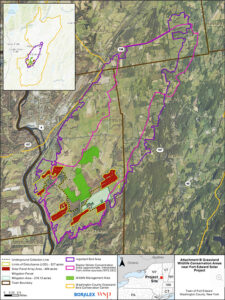By Ben Westcott, Chronicle Staff Writer
Boralex, the Canada-based renewable energy producer, plans to build a 100 megawatt solar power facility on 530 acres leased from about 30 private land owners in Fort Edward.
The Schuylerville-based not-for-profit, the Grassland Bird Trust, claims it will be “disastrous” to birds and wants more acreage preserved than is planned or required.
In an Oct. 31 press release, the Trust said it “supports renewable energy and did not attempt to stop this project” but has asked for a “compromise” that entails Boralex “conserving 567 acres of grassland bird habitat, the same amount of land as will be covered with solar panels.”
That’s much more than the 216 acres of “mitigation land” required by the state’s Office of Renewable Energy Siting and Electric Transmission for the project.
Boralex: We did reduce the scope
Boralex Public Affairs Director Zack Hutchins told The Chronicle, “Boralex approached the GBT [Grassland Bird Trust] at the start in 2019. The entire project is planned for privately owned land that at any moment could be altered by nature or a change of use.

“Our current project plan will mitigate over 216 acres directly adjacent to the Wildlife Management Area. This will increase the protected area in Fort Edward to over 700 contiguous acres.”
Mr. Hutchins said, “Boralex has worked with leading researchers and scientists to design a project that will encourage grassland birds in the project footprint. There is evidence that some grassland bird species occupy solar facilities if proper care is taken….
“Our first objective was to avoid potential impacts, so after extensive conversations with key stakeholders we designed the project to minimize impacts. Boralex remains committed to working with the GBT to avoid and mitigate the impacts.”
Cornell ornithologist: Damage
The Bird Trust says the site is in an Audubon-designated Important Bird Area, a Natural Heritage Winter Raptor Concentration Area and close to a nearly 500-acre NYS DEC Wildlife Management Area managed for grassland birds.
Samantha Carouso Peck, who has a PhD in ornithology from Cornell University and was then the executive director of the Grassland Bird Trust, said at a Sept. 30 Public Comment Hearing at Durkeetown Baptist Church in Fort Edward that “solar field construction has been demonstrated by multiple studies to have substantial negative impacts on birds…
“The choice to build on hundreds of acres within the heart of the Washington County Important Bird Area will be a disastrous one for the continued survival of the threatened species who live there.”

She added that the grasslands are “the last breeding habitat for many other grassland bird species.”
The Grassland Bird Trust acknowledged in a press release, “There is no indication to date that [the State agency] ORES will require Boralex to mitigate the damage to the grassland birds by conserving more than 216 acres,” but the Trust is “not giving up.”
Social media influencer fights it
Alexandra Fasulo, 32, was another speaker at the public hearing. She’s an activist and influencer living on a farm in Schuylerville who has 650,000 followers on Instagram, 349,000 followers on Youtube, and 100,000 followers on Facebook.
Ms. Fasulo said she has started a nonprofit called American Land Rescue Fund “defending America’s land through law and action,” its website says.
“Our first legal case we’re hoping to bring against the state is that of Fort Edward Solar: a solar industrial complex of 1,800+ acres planned for DEC-designated grassland habitat that’s home to two endangered and dozens of threatened species. ORES has crushed local town boards and environmental designations to push through what is arguably one of the most ecologically catastrophic green energy experiments to date.”
Ms. Fasulo has been posting strongly on social media against the project.
“To install the solar panels, they have to eradicate the grasslands,” she told The Chronicle. “They have to mow down and clear the habitat of the grasslands to install the panels. And then to maintain the panels, most times they use herbicides. In their files they’ve admitted there will be herbicide application to make sure the vegetation around the panels is suppressed. So that means Roundup and other poisonous stuff is going to get soaked into the soil there, and there’s also wetlands present.
“Raptors need open grasslands to hunt and survive and not starve to death. Blanketing their habitat in solar panels prevents them from hunting. So it will cause the species that are endangered there to move closer towards extinction.
“To me there’s no point of trying to be carbon neutral if we’ve just completely annihilated the environment in the process. I’m asking for this project to be relocated completely. There is no pathway where having the location they have chosen ends well for the environment.”
Asked by The Chronicle about Ms. Fasulo’s views, Boralex Vice President of Public Affairs and Communications Darren Suarez, emailed: “Boralex values the local ecosystem and shares a strong commitment to protecting the biodiversity of this private land and during the construction phase, we will take extraordinary, documented steps to protect and minimize disturbance to natural resources.
“For more than five years, we have collaborated closely with environmental experts and conservation groups, to meet or exceed strict federal and state regulations. To demonstrate our commitment, we will utilize an operating strategy which proactively preserves habitat quality by prioritizing sustainable methods like targeted grazing, strategic mowing, and the selective planting of native, pollinator-friendly species.”
Project supporters also spoke
While a dozen speakers at the Sept. 30 public comment session spoke against the project or urged modifications, seven spoke in favor of it.
“This project,” said Tonya Tozzi, “allows the farmers to keep the working part of their farm so that they can continue to own and keep the farms in their families for generations to come.”
She said Boralex is “very workable, they want to work with the community” and that the project will generate taxes Fort Edward, noting, “A couple years ago the school was almost shut down completely because it did not have enough revenue.”
She said Boralex has allocated a “large tract” towards the bird sanctuary.
“I know you guys want more,” she said. “But these are private landowners, and I don’t really believe that anybody should be coming in and saying that a private landowner should have to hand over property to anyone.”
Walter Long III said, “I’ve lived out here for 30 years. I’ve seen farms go away, and now they’re big Bird Trust areas.
“And all these Bird Trust areas, they don’t do nothing. They don’t pay property taxes…And the property taxes that they’re not paying has caused my property taxes to go sky high.
“And also, everywhere you look, your electronic use is getting higher and higher. So next time you want to think about raising a fuss by some bird who’s still got lots and lots of land, because they live all over the place, think about that. Because if you put a squash on this right here, you might not have any electricity to run all those things you like so much.”
A man referred to as Mr. Dudley who lives on St. James Road said, “I have a solar farm behind my house. They say it’s an eyesore. But I wake up every day…and all it looks like is a building with no sides. There’s no glare. And I know it’s putting energy into our power lines. And the deer population is still there. The turkeys are there. The bunny rabbits are there. The birds are there.”
‘Quiet, emission-free electricity’
Mr. Hutchins, the company Public Affairs Director, says, “Boralex has been a presence in the greater Fort Edward area for more than two decades and New York needs additional electricity to meet growing demand.
“This area was identified as a suitable location for a solar facility because of the quality of the solar resource, willingness from local landowners to participate, and proximity to transmission lines.
“Our participating landowners are excited to utilize their private property for renewable energy generation. Residents of Fort Edward and Washington County will be able to say they’re directly impacting New York State reaching climate initiatives.”
Boralex’s website says the facility will provide “quiet, emission-free and reliable power generation for the equivalent of approximately 28,000 NYS households per year” and help the state “achieve its goal of 70% clean power generation by 2030 and 100% by 2040.”
Other benefits it cites include “approximately 120 jobs created during construction, long-term jobs to support operations and maintenance, and significant tax revenues to the Town of Fort Edward, Washington County and Fort Edward Union Free School District and Hudson Falls Central School District.”
Boralex’s website headlines, “Renewable Energy at the Heart of Global Decarbonization” and elaborates, “Electricity is at the heart of the fight against climate change. Accelerating the deployment of renewable sources of energy is essential to reducing worldwide emissions while supporting sustainable economic growth.
“As an independent renewable energy producer in North America and Europe, we have been working toward a net-zero future for over 30 years. At each step of the energy value chain — development, construction, operation, sales and beyond — we deliver renewable energy solutions for a sustainable future.”
The estimated footprint of 530 acres includes solar arrays and other project features such as access roads, a substation, and an electrical interconnection to the National Grid 115kV circuit, the site said.
Originated in 2019, the project is set for completion in December 2027 under the current timeline, and is anticipated to be operational for 30 to 35 years.
Copyright © 2025 Lone Oak Publishing Co., Inc. All Rights Reserved
 Glens Falls Chronicle Serving the Glens Falls/Lake George region; Warren, Washington and northern Saratoga counties since 1980
Glens Falls Chronicle Serving the Glens Falls/Lake George region; Warren, Washington and northern Saratoga counties since 1980


